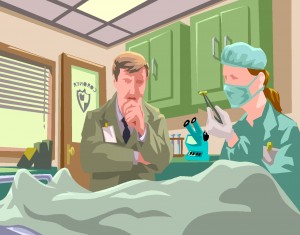Have you noticed how detectives can call their favorite medical examiner minutes after they left a crime scene for a report? Does this timeframe seem too brief for your own story? In real life, detectives can wait a considerable time before they see anything from a medical examiner.
On September 21, 2012, The New York World posted an article about these delays in New York: “More Work, Fewer Staff Add Up to Longer Waits for Medical Examiner Reports.” For example, the Medical Examiner office needed about 46 days to provide DNA test results in sexual assault cases. Toxicology reports required about 60 days. Can’t detectives grab a bite after visiting a crime scene and then call the ME for autopsy results? Sure, but they shouldn’t expect an answer. An autopsy takes about 70 days to complete.
So, if you want to delay the appearance of test results in your story, then don’t worry about it. Any delays will just make the story more realistic.




